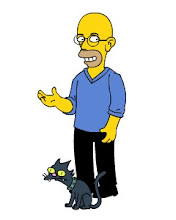Caught an interesting science programme on BBC4 the other night. It dealt with the infamous Many Worlds interpretation of quantum mechanics, but from the perspective of the musician Mark Everett (or E), son of the scientist who developed it, Hugh Everett. While I knew of both of these people separately, I was completely unaware that they were related, let alone father and son.
The programme followed Mark as he travelled the US meeting up with Everett's colleagues and with scientists currently working with Many Worlds. The programme devoted some time to the theory itself, but focused more on Everett's life and academic career, and with Mark's relationship with his father. While it probably overstated the importance of Many Worlds, and may give some viewers the idea that this interpretation is the most commonly accepted one among physicists, it was really quite charming.
Mark, who hitherto understood very little about his father's work, gradually came to some understanding of it, and was able to make sense of father's life and certain key events in it. He also came to realise the importance of his father's work, and the modern relevance of the Many Worlds interpretation. A particularly choice moment was when he dug out some old audio tapes from his father's stuff (Everett died in 1982). These recorded conversations with friends and scientific colleagues about his ideas. However, in the course of playing through them, Mark found a recording of their pet cat purring, a boastful recording of himself and, best of all, a conversation his father was having that, in the background, had Mark learning to play the drums.
My own view on Many Worlds is that, while I don't subscribe to it, I find its solution of the "measurement problem" strongly preferable to that of the "standard" Copenhagen interpretation. I simply refuse to buy the idea that measurement is an important factor in the lives of subatomic particles. At first glance, this seems a reasonable deduction given that quantum objects appear to switch from waves to particles when measurements are made of them. The large number of possibilities inherent in waves is instantly decreased to a single actuality by the act of measurement. But it's unclear (to me anyway) what "looking at" a quantum object does to it to make this happen. Many Worlds resolves this by stating that all of these possibilities actually occur, but do so in their own separate universes, such that we only see one outcome (i.e. we, too, are split across multiple universes). While this does elegantly sidestep the measurement problem, it does so at the great expense of an ever-expanding number of universes. I'm not prepared to make that leap. My own view is more along the lines of the neo-realist Bohm interpretation. In my understanding of it, this posits that quantum objects have hidden variables associated with them, such that they are composed of both wave and particle components. These hidden variables explain the dual behaviour of the objects but measurement is not a special process. Of course, this interpretation fails Occam's Razor by profligately introducing unobserved (possibly unobservable) hidden variables. Still, it allows me to continue believing in an external world that carries on regardless of our actions.
Wednesday, 28 November 2007
Subscribe to:
Post Comments (Atom)










No comments:
Post a Comment